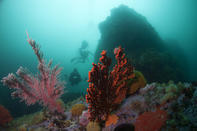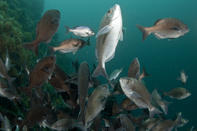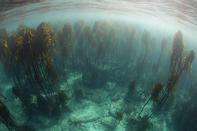Miller's Point
Average depth: 7m / Maximum depth: 18m
The scenery at Miller’s Point consists mainly of walls and gullies with patches of kelp everywhere. This reef has the typical False Bay marine life with bright colours - the rocks are covered with colourful Sea urchins and beautiful anemones. This site is in a protected area and the water is usually clear and calm. Miller’s Point is a very popular training dive site.

This reef has the typical False Bay marine life with bright colours - the rocks are covered with colourful Sea urchins and beautiful anemones. This site is in a protected area and the water is usually clear and calm. Miller’s Point is a very popular training dive site.
SAS Pietermaritzburg

Average depth: 16m / Maximum depth: 22m
This shipwreck lies upright in the sand and is still in very good condition - on a clear day with good visibility it makes for an excellent dive with a somewhat eerie feel. This is an excellent location to do wreck penetration as it is not too deep and the wreck is fully intact.
The wreck houses abundant marine life and is a safe haven for many species of fish, such as Janbruins, Hottentots and Romans. The odd seal makes an appearance from time to time and colourful Nudibranchs and anemones are also seen on this lovely wreck. The best time to dive the SAS Pietermaritzburg is in the winter months. The ship was formerly known as the HMS Pelorus and it led the invasion of the Normandy in World War II. In 1947 the South African Navy bought and used this vessel before sinking it in 1994 to create an artificial reef.
Spaniard Rock
Average depth: 8m / Maximum depth: 12m
Spaniard Rock is covered in brightly coloured sponges and is frequented by marine life such as big Brittlestars, Feather stars and brightly coloured Cape urchins. The site gets its name from all the yellow, orange and red colours that you see on this dive which are reminiscent of the Spanish national flag. You will also encounter lots of reef fish on this site, while Klipfish, Pipefish, Shysharks and Nudibranchs are also commonly seen in this area.
Pyramid Rock

Average depth: 8m / Maximum depth: 12m
This area is characterised by a pyramid shaped rock that sticks out of the water about one metre high. The big submerged rocks and swim-throughs make it a very interesting dive. A pristine kelp forest, just a few metres off the beach with long tunnels and caves to explore around the pyramid-shaped rock, makes this site worth diving.
There is usually a bit of surge running at this site except in extremely flat conditions. Close to shore many of the Whelks and Sea snails familiar to seashore rock pools are found as part of the abundant and colourful invertebrate life. There are many big reef fish and the terrain between the rock and the exit point is covered in kelp that often shelters small octopus and small Shysharks.
 False Bay is so named because many sailors returning from the East used to mistake Cape Hangklip (near Hermanus) for Cape Point. As a result...
False Bay is so named because many sailors returning from the East used to mistake Cape Hangklip (near Hermanus) for Cape Point. As a result... Self drive routes from Cape Town invite visitors to the Mother City to experience the natural splendour, fun activities and scenic attractio...
Self drive routes from Cape Town invite visitors to the Mother City to experience the natural splendour, fun activities and scenic attractio...